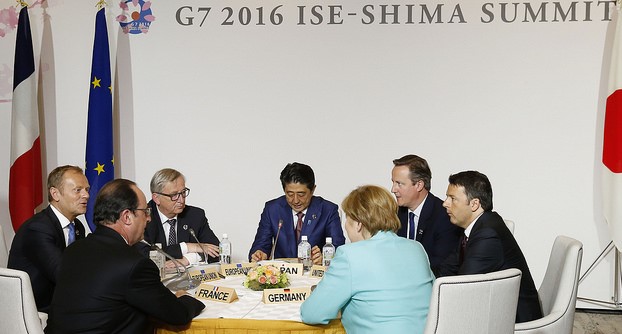How G7 can Boost the Global Economy

Collective action by the G7 would be enough to make a big difference to the world’s sputtering economy but it requires a change in the ideology that binds these like-minded countries together. The rise of presidential hopeful Donald Trump in the US and the far right in Europe are warning signs of what might happen if they don’t.
The big economic issue on the agenda at the G7 is the continued sluggish growth of the global economy. While the group of seven major advanced countries does not include rising powers such as India and China, it still accounts for more than a third of the world’s GDP. Plus its limited membership of like-minded countries means it may be one of few meetings that can actually make a difference.
It is perhaps fitting that this year’s G7 is hosted by Japan, where weak growth and deflationary forces have held back the economy for some 26 years. The Japanese experience presents not only a warning but also useful lessons about what might work and what doesn’t work when it comes to boosting growth.
Japan’s problems began following the collapse of a huge debt-fuelled asset boom in the 1980s. Debt overhang combined with an ageing population has slowed aggregate demand since. In response the government has maintained budget deficits and employed an extremely aggressive monetary policy. This prevented outright depression, but the economy is still struggling, monetary policy appears increasingly ineffective, and government debts now stand at over 200% of GDP.
We’re all Japan now
The similarities in Europe and the US now are all too clear. Once again the collapse of a huge debt-fuelled asset bubble in 2007 has left the private sector grappling with unmanageable debts. And similar policies to Japan of deficit spending and aggressive monetary policy has been used, with limited effect. In Europe the problems have been compounded by a dysfunctional monetary union that slows decision making and hinders necessary economic adjustments, leading to outright depression in some countries (such as Greece).
Much of the policy response has tried to stimulate demand among populations. But several years of deficit spending, combined with low interest rates have failed to generate a robust recovery, highlighting the unusual nature of our current economic environment. Quantitative easing has injected massive amounts of money into the financial system, with little benefit to the real economy.
An alternative policy that has recently gained attention is overt monetary finance, better known as helicopter money. Like quantitative easing this involves creating new money. But rather than buying assets with it, it is used to fund government spending (or tax cuts so households might increase their spending). This would guarantee an impact on the real economy. While this type of policy has historically been associated with hyperinflation, in a deflationary environment small doses could be beneficial. Yet, despite generating some high profile support, it is no doubt too radical for policymakers at this year’s G7.
An unenviable situation
Instead, going forward the policy mix looks like it will be more of the same, with the hope that recovery will eventually take off. This optimism has been supported by some favourable economic stats coming out of the US. But low unemployment figures are deceptive, masking a weak labour market in which participation rates are low, with hours worked insufficient for many workers and a high level of bogus self-employment. Similarly, the occasionally impressive quarterly growth rate is not nearly enough to make up for lost gains. Perhaps the biggest issue, though, is that wages are still stagnating for the majority or workers.
Politicians are generally more comfortable talking about structural reforms. These vary in detail but often involve making labour markets more flexible (or brutal) by reducing job security and other protections. It gives them a chance to show how “responsible” they are by taking “tough choices” and implementing “painful medicine”. But such programs have been continuously implemented for many years now, and did not prevent the financial crisis, nor help generate a recovery. Indeed they increasingly seem to result in worsening inequality.
We find ourselves in the unenviable position in which we have the choice between unsustainable debt-fuelled growth or stagnation. One of the main underlying causes relates to the huge increases in inequality in recent years. We have created a society in which ownership pays (through profits and rent) but work doesn’t. In the US, many workers’ wages have been stagnant or growing anaemically for a long time. More recently this trend has spread elsewhere. As a result, many households have been forced to maintain spending through unsustainable borrowing.
Moving forward
Solutions to our current economic malaise are more difficult than the leaders at the G7 may want to face up to. They include more progressive taxation (particularly on wealth) and ending offshore tax havens. This would help generate revenues needed to pursue a modern industrial strategy (one that heavily focuses on the transition to renewables). It is also important to return to growth that includes an increase in people’s wages. This will require stronger trade unions working with both government and business.
Some may point out that these policies have been (unsuccessfully) tried before, leading to the phenomenon of stagflation in the 1970s. But the current free-market approach has also failed before (in the 1930s), which did not stop its resurgence in the 1980s. And it has been clear for some time that it is failing again.
These polices will obviously need updating for the 21st century. And they will require international cooperation. However, unlike other global problems such as climate change, the proposals outlined here do not require full international cooperation. The G7 acting together would be enough to make a huge difference. But it does require a change in the dominant ideology that binds these “like minded countries” together. The rise of presidential hopeful Donald Trump in the US and the far right in Europe are a warning sign of what might happen if they don’t.
Gareth Downing is a senior lecturer in economics, strategy, marketing and economics at the University of Huddersfield in England. This article originally appeared in The Conversation on 26 May. It is republished with permission.





